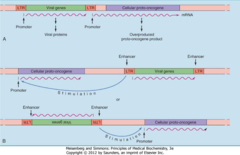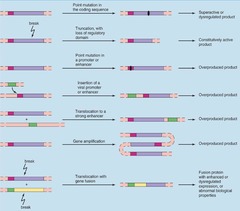Cancer, Proto-oncogenes, Tumor Suppressor genes – Flashcards
Unlock all answers in this set
Unlock answersquestion
Normal cell growth
answer
- Cell proliferation is mitogen dependent - Cell growth is anchorage dependent - Cell growth is contact inhibited - Cells are mortal
question
Cancer phenotype
answer
- Loss of normal cell-cell interactions - Loss of normal cell cycle regulation
question
Cancer arises when?
answer
Somatic mutation creates gene that causes cell to uncontrollably proliferate. Creates a neoplasm
question
Monoclonal origin
answer
Most tumors derived from a single abnormal ancestor
question
Benign tumors
answer
Limit their growth, don't do much harm
question
Malignant tumors
answer
Kill organism
question
Cancer cells
answer
- Abnormally high mitotic rate - Become similar to stem cells - Show disordered growth (anaplasia) - Can colonize distant tissues (metastasis) - Genetically unstable - Grow in absence of mitogens - Immortal
question
Proto-oncogenes (c-onc)

answer
Code for normal cell functions involved in growth and differentiation.
question
Tumor cell characteristics
answer
- Inappropriate regulation of cell growth - Loss of contact inhibition - Unstable number of chromosomes - Release transforming growth factors - Protease secretion - Altered surface proteins - Altered gene transcription
question
Malignant
answer
Capable of spreading. Metastasis
question
Slow transforming RVs

answer
c-onc not damaged, but transcription rate is increased. - Promoter insertion - Enhancer insertion
question
Do non-viral tumors contain oncogenic DNA sequences?
answer
Yes.
question
Rous sarcoma virus
answer
RV containing small RNA genome with *gag, pol, and env* genes. v-src not required for replication.
question
v-src
answer
Viral oncongene. Causes abnormal proliferation of virus infected cells. Expressed at high rate under direction of viral promoter and enhancer in LTRs.
question
Normal SRC proto-oncogene
answer
Closely related to v-src. Both code to NR-TPK loosely bound to membrane.
question
Base substitution in oncogenes
answer
Ras allele point mutations
question
Normal Src kinase
answer
Controlled by GF receptors and focal adhesion proteins. Stimulates mitosis by phosphorylating same proteins as GF receptors
question
Ras allele
answer
Classical point mutations turns normal ras into tumor DNA. 3 AA positions involved
question
Ras mutations
answer
Normal ras: GGT-GCA-CAA (Gly-Ala-Gln) Lung carcinoma ras: TGT Ki MSV ras: AGT-ACA
question
Proto-oncogene
answer
Gene that normally codes for growth promoting protein becomes *abnormally activated*. ---> Oncogene Only requires activation of one copy of gene. (Dominant expression)
question
Oncogene
answer
Mutated proto-oncogene
question
Tumor suppressor genes
answer
Codes for inhibiting protein, prevents cancerous growth. *Expressed as a recessive trait*- both copies must be inactivated to promote abnormal growth.
question
Classes of proto-oncogenes
answer
- Growth inhibiting proto. - Growth inhibiting cancer suppressor genes - Genes that regulate apoptosis - Genes that regulate DNA repair
question
Oncogenic protein
answer
Bind growth factor to its specific receptor, activation turns on signal transduction pathway to activate DNA transcription. Cell enters cell cycle, results in cell division.
question
Proto-oncogene activation
answer
Single activating mutation is sufficient to produce abnormal cell growth. (GOF mutation) -Products are growth-stimulating proteins
question
Tumor suppressor gene activation
answer
Two inactivating mutations necessary for abnormal cell growth. (LOF mutation) -Normal products are growth inhibiting proteins, so inactivation means loss of inhibition.
question
Proto-oncogene conversion
answer
- Mutations - Translocations - Over expression - Inappropriate expresion during cell cycle Mechanisms that can covert them to tumorigenic genes
question
Proto-oncogene conversion mechanisms

answer
- Structural changes to gene, resulting in oncoprotein - Regulatory changes in gene expression, resulting in enhanced production of growth promoting protein
question
Proto-oncogene normal functions
answer
- GFR - Adhesion molecules - ras (signal transducer) - cyclin D (cell cycle regulator) - myc (TF) - p53 - BRCA-1/2 (DNA repair) - Rb (cell cycle inhibitor)
question
Growth factors
answer
Uncommon as oncogene products. - simian sarcoma (sis) gene, only one known to code for GF - Some spontaneous cancers stimulate autocrine loop
question
Growth factor mechanism
answer
- Activation of oncogene coding for GF - Abnormal amount of GF - Receptors bind GF and signal transducer - Stimulation of cell growth
question
Growth factor receptors
answer
RTKs over-expressed or structurally altered in malignant tumors.
question
GF receptor mechanism
answer
- Amplification of oncogene coding for GFR - Abnormal amount of GFR produced - Receptors bind signal transducer - Cell growth stimulation
question
erb-B oncogene
answer
Codes for EGF receptor that has lost EC ligand binding domain. *Phosphorylates products at all times, even in absence of EGF*
question
neu oncogene
answer
Single substitution point mutation keeps receptor active at all times
question
Signal transducing proteins
answer
- Mutant signal transducer protein produced - Mutant transducer remains active after release of GF - Mitogen independence and anchorage independence
question
P13K
answer
P13K ---> + Akt ---> Inhibits GSK3 ---> Inhibits cyclins
question
ras proteins lost?
answer
Lost their OFF switch. Remain active at all times.
question
ras mechanism
answer
Normally inactive. Activation requires GDP phosphorylation. Signal transduction through MAP kinase pathway. GAP binds to ras, cleaves GTP back to GDP.
question
ras cancers
answer
- Lung - Colon - Pancreatic (90%)
question
Oncogenic ras
answer
Make ras unresponsive to GAP. Lost "off" switch, remain in active state.
question
Neurofibromin
answer
Stimulates GTPase activity of Ras. Wants to turn it off.
question
Neurofibromatosis Type 1
answer
Mutation inactivates NF, which normally turns off ras. Tumor cells have elevated ras signaling. - Cafe au lait spots - Benign but disfiguring nerve sheath tumors along peripheral nerves.
question
RAF-1
answer
Similar regulation to ras. Oncogenic form loses negative phosphorylation sites, or whole regulatory domain.
question
Cell cycle promoters
answer
- Oncogenes ---> Activation produces cell growth
question
Cell cycle inhibitors
answer
- Tumor suppressors ---> Inactivation induces cell growth
question
pRb
answer
Inhibits cell cycle. Cyclin D phosphorylates pRb, entering cell into S phase
question
Burkitt's lymphoma
answer
Chromosome 8 and 14 translocation. Results in increased myc protein
question
Retinoblastoma
answer
Homozygous inactivation of RB1 gene in cancer cells, leading to defective G1 checkpoint. (2 hits)
question
Sporadic form
answer
Single tumor, no family history. Require 2 somatic mutations to eliminate both copies of RB1 to develop cancer.
question
Familial form
answer
Autosomal dominant trait, presents in multiple tumors. Born with heterozygous for an inactivating RB1 mutation, require 1 somatic mutation to develop cancer.
question
Retinoblastoma gene
answer
Deletion of 13q14.1. Normally codes for p105-RB, which is expressed in normal retinal tissue and regulates the cell cycle by binding transcription factors.
question
Cancer susceptibility syndrome
answer
Individuals born with heterozygous mutation in a tumor repressor gene. Susceptible to somatic mutation that causes the cell to lose both copies of TSG.
question
p53 function
answer
Detects DNA damage. Attempts to repair damage. If not repaired, cell triggered for apoptosis.
question
Mutated/loss of p53
answer
No cell cycle arrest, therefore no DNA repair. Mutant cells become malignant
question
DNA oncogenic viruses
answer
- HPV - EBV
question
HPV Types
answer
Types 6 and 11 have low risk malignant potential, form genital warts.
question
HPV mechanism
answer
Viral E6/E7 genes integrated in host DNA. E7 binds to pRb, displacing E2F TFs. E6 binds to p53 and degrades it. Changes in transcription lead to increased cell proliferation and increased rate of somatic mutations.
question
EBV
answer
Infects epithelial cells of oropharynx and B-cells. EBC forms an episome in B-cell genome, makes cell immortal. Activates LMP-1 which prevents apoptosis by up-regulating bcl-2 expression.
question
Cell surface receptors
answer
Binding of TGF-B to receptors up regulates transcription of growth inhibitory genes.
question
Loss of cadherins
answer
Favors malignancy by allowing easy disaggregation of cells
question
DNA repair regulator genes
answer
Those born with a mutation in DNA repair proteins have an increased risk of developing cancer. - HNPCC syndrome
question
Xeroderma Pigmentosum
answer
Individuals have increased chance of developing melanomas and squamous cell carcinomas as a result of exposure to UV. Unable to fix DNA regions with chemically modified bases.
question
BRCA-1 and BRCA-2
answer
Associated with breast and ovarian cancer. Proteins involved in homologous recombination repair process.
question
Adenomatous polyposis coli (APC)
answer
Colonic mucosa becomes studded with thousands of polyps. Heterozygotes have a loss of APC in all cells, and inactivation of the remaining APC gene can create a polyp.
question
Colorectal Cancers
answer
Develop from benign tumors. Homozygous inactivation of APC TSG can form a benign polyp.
question
B-catenin
answer
Inactivation of APC gene prevents destruction of b-catenin. Accumulating B-catenin stimulates gene expression permanently.
question
Colorectal cancer mechanism
answer
1. Loss of APC TSG 2. Activation of K-ras oncogene 3. Loss of DCC TSG 4. Loss of p53 TSG 5. Cancer metastasizes
question
Apoptosis
answer
Regulated by bcl-2. Effector is caspase.
question
myc lymphoma
answer
Excess cells produced.
question
bcl2 lymphoma
answer
Excess cells do NOT die.



